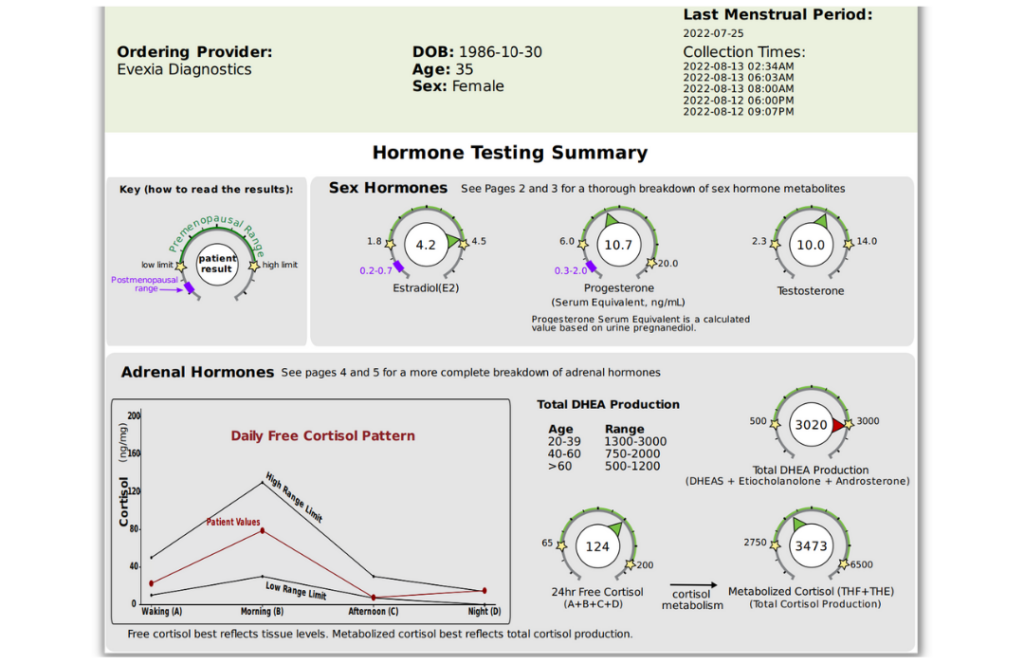Unlocking Hormone Health: How I use the DUTCH test in my nutrition practice
I specialize in women’s health, so it’s no surprise that many clients who come through my virtual door have some type of complaint about their hormones. From fertility issues to night sweats, painful periods, and beyond, our female hormones—estrogen, progesterone, testosterone, cortisol (and so many more)—seem to be causing a whole slew of trouble these days.
Why?
The short answer is our modern lifestyles. But we don’t have time to dig into all the root causes in this post; otherwise, we’d be here all day. It’s important to note that hormones themselves are NOT the root cause of your symptoms. Yes, your hormones may be out of balance and causing those awful issues, but they aren’t doing so for no reason. There’s always an underlying issue driving that imbalance—whether it’s stress, blood sugar dysregulation, gut inflammation, or something else. Hormones are messengers; they cause mayhem to signal that something deeper needs attention.
When clients present with hormone-related concerns—let’s use some common perimenopause symptoms as examples:
- Mood swings
- Sudden weight gain
- Inability to lose weight
- Fatigue
- Short cycles
- Heavy bleeding
- Night sweats
- Anxiety and depression
The first step is to rule out underlying root cause issues like poor gut health. If these symptoms don’t clear up on their own, it’s time to dig deeper into the hormone puzzle. For some clients, it makes sense to look at hormone levels alongside other root cause work so we can alleviate symptoms while deeper root cause work takes place.
Enter the DUTCH test.
What is the DUTCH test?
In my practice, I believe in testing rather than guessing. While symptoms can guide us in making lifestyle, supplement, and nutrition changes, having real data allows us to be precise and effective. Functional lab testing (you can read more about the labs I use by clicking HERE) is key to cutting through the noise and achieving faster results.

When it comes to hormone health, the DUTCH (Dried Urine Test for Comprehensive Hormones) test is my go-to. Here’s why:
- Comprehensive Hormone Insight: Unlike a standard blood test, which only gives a snapshot of your hormone levels, the DUTCH test provides a full view of both hormones and their metabolites. This helps us understand how your body is processing and clearing hormones—a crucial piece of the puzzle.
- Cortisol Rhythm Tracking: The DUTCH test measures cortisol levels throughout the day, giving us a clear picture of your adrenal function and stress response. This is a major step up from a single blood draw, which can’t capture the daily fluctuations.
- Hormone Metabolism Analysis: With the DUTCH test, we can see which detox pathways your estrogen is taking. This insight is essential for assessing your risk factors and tailoring your protocol, something blood and saliva tests just can’t match.
- Convenience and Comfort: The test is done at home over 24 hours, making it less stressful and more convenient than multiple blood draws or trying to produce enough saliva for a test.
- More Accurate Free Hormone Levels: Blood tests usually measure bound hormones, but the DUTCH test provides a more accurate assessment of the free, bioavailable hormones that your body is actually using.
Based on your results, I can tailor your protocol using food, lifestyle, and supplemental interventions to help rebalance things out and reduce the severity of symptoms while you work on other root causes. Let’s look at an example.
How I use the DUTCH
First, let’s clarify who the DUTCH test is not for:
- Anyone with Gut-Forward Symptoms: If your primary issues are related to gut health, it’s usually more effective (and cost-efficient) to start with stool testing. Often, hormone imbalances clear up when gut health is restored, so there’s no need to jump straight into hormone testing.
- Anyone on Hormonal Birth Control: The DUTCH test will primarily reflect the synthetic hormones from your contraceptive, which isn’t helpful in assessing your natural hormone levels. The exception is if we’re focusing solely on cortisol levels, which can still offer valuable insights. Ideally, you should wait at least three cycles after discontinuing birth control before testing hormones.
- Breastfeeding Women: Hormones are naturally all over the place during breastfeeding, making it difficult to get actionable data. It’s best to wait at least three months after you’ve finished nursing before doing the DUTCH test.
Depending on where you are in your hormone journey (e.g., cycling vs. menopause), the timing of the test is crucial. For those still cycling, it’s best to test during the peak of your luteal phase (5-7 days post-ovulation) to get the most accurate hormone readings.
An Example:
Now that we’ve covered who the DUTCH test is (and isn’t) for, let’s dive into how I actually use it in my practice. The best way to illustrate this is by walking you through a real-life example—my own DUTCH test from 2022.
But before we get into the details, I want to emphasize once more that hormones are just one piece of a larger puzzle. The DUTCH test is most effective when used after or in tandem with foundational changes like stress reduction, blood sugar management, gut health improvement, and sleep optimization. These are the key factors that need to be addressed to truly get to the root of your hormonal imbalances.
Back in 2022, I was struggling—big time. And to be honest, in some ways, I still am. Good hormone health isn’t a final destination; it’s a constant balancing act, y’all. But back then, my main issues were hormonal acne, short cycles (21 days), anxiety, poor sleep, brain fog, and low energy.
Here’s a screenshot of my DUTCH test results:

I know the results look like gibberish if you’re not used to reading DUTCH tests, so let me break down my two biggest takeaways:
- DHEA was slightly above range, indicating that my adrenals needed some TLC, particularly in the area of blood sugar stability.
- Estrogen was on the high side—especially when compared to my progesterone levels. While both were technically within the “normal” range, that doesn’t necessarily mean optimal. This imbalance can lead to many of the symptoms I was experiencing.
There were other nuances in my results, but they aren’t as interesting and didn’t alter my protocol.

Here’s how I turned these insights into actionable steps:
- Estrogen Detox & Progesterone Support: I added DIM to support estrogen detox and Vitex for progesterone support—both are common supplements in hormonal protocols.
- Dietary Changes: I increased liver-loving foods like cruciferous veggies, beets, beans, and citrus fruits to aid in detoxification.
- Adrenal Support & Stress Management: I introduced adaptogens to support my adrenals and focused on reducing stress wherever possible. I also pivoted from cardio-based exercise to more resistance training.
- Blood Sugar Balance: I concentrated on balancing my blood sugar by increasing protein intake and avoiding “naked” carbohydrates.
The results?
I slowly noticed improvements over time, but things didn’t really kick into gear until I’d been on the protocol for about 2.5 months (which is typical for hormone protocols). My cycle lengthened to an average of 28 days, brain fog lifted, energy levels rose, and I felt much better in my body. I’m always a work in progress (acne still plagues me), but overall, I’m really happy with where my hormone health is today.
Now It’s Your Turn
If this blog hits close to home, you know what to do. The first step in digging deeper into your hormone health is to reach out. All of my 1:1 programs include the option to add a DUTCH hormone test, but remember, hormones are never the first step in the journey to balance—you’ve got to work on those root cause issues too!
To get started, fill out an application to work with me. We’ll then hop on a free discovery call to learn more about each other and see if we’re a good fit.
And if you’re reading this before September 5th, be sure to sign up for my free online workshop: Is it Perimenopause? Simple Steps to Balance Your Hormones (& Your Life!). If a DUTCH test is on your radar, you don’t want to miss this workshop (hint: there may be a bonus involved 😉).
I hope this blog has shed some light on how I use the DUTCH test in my practice. As always, don’t hesitate to reach out if you have questions—you’re welcome to email me or send me a DM over on Instagram.